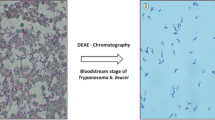Abstract
Trypanosoma evansi infection (surra) causes significant losses in livestock production in tropical and sub-tropical areas. The current ELISA recommended by OIE for diagnosis of the disease is based on trypanosome lysate antigen. However, antigenic variation and unstable nature of cell lysate antigen make it difficult to standardize the assay. Thus, there are needs to develop recombinant antigen-based ELISA that improve stability, sensitivity, and specificity of the test. Since tandem repeat (TR) proteins of trypanosomatid parasites generally possess high antigenicity, they have been considered to be the promising antigens for trypanosomosis and leishmaniosis. In this study, IgG responses against 14 recombinant TR proteins of trypanosomes were examined by ELISA. Serum samples were obtained from three water buffaloes experimentally infected with T. evansi. Since Trypanosoma congolense GM6 (TcoGM6) elicited highest IgG responses to all water buffaloes, we further bioinformatically and molecular biologically identified Trypanosoma brucei brucei GM6 (TbbGM6) and T. evansi GM6 (TeGM6) TR genes, respectively. As expected, predicted amino acid sequences of TbbGM6 and TeGM6 were identical while the nucleic acid sequence homology between TbbGM6 and TcoGM6 was 63.8%. All buffaloes became clearly positive in recombinant TbbGM6 (rTbbGM6)-based ELISA at 48 days post-infection, suggesting that rTbbGM6 is usable as a serodiagnostic antigen for chronic T. evansi infection.




Similar content being viewed by others
References
Benson G (1999) Tandem repeats finder: a program to analyze DNA sequences. Nucleic Acids Res 27:573–580
Camargo RE, Uzcanga GL, Bubis J (2004) Isolation of two antigens from Trypanosoma evansi that are partially responsible for its cross-reactivity with Trypanosoma vivax. Vet Parasitol 123:67–81
Claes F, Radwanska M, Urakawa T, Majiwa PA, Goddeeris B, Büscher P (2004) Variable Surface Glycoprotein RoTat 1.2 PCR as a specific diagnostic tool for the detection of Trypanosoma evansi infections. Kinetoplastid Biol Dis 3:3
Desquesnes M, Davila AM (2002) Applications of PCR-based tools for detection and identification of animal trypanosomes: a review and perspectives. Vet Parasitol 109:213–231
Desquesnes M, McLaughlin G, Zoungrana A, Davila AM (2001) Detection and identification of Trypanosoma of African livestock through a single PCR based on internal transcribed spacer 1 of rDNA. Int J Parasitol 31:610–614
Goto Y, Coler RN, Reed SG (2007) Bioinformatic identification of tandem repeat antigens of the Leishmania donovani complex. Infect Immun 75:846–851
Goto Y, Carter D, Reed SG (2008) Immunological dominance of Trypanosoma cruzi tandem repeat proteins. Infect Immun 76:3967–3974
Goto Y, Carter D, Guderian J, Inoue N, Kawazu S, Reed SG (2010) Upregulated expression of B-cell antigen family tandem repeat proteins by Leishmania amastigotes. Infect Immun 78:2138–2145
Goto Y, Duthie MS, Kawazu S, Inoue N, Carter D (2011) Biased cellular locations of tandem repeat antigens in African trypanosomes. Biochem Biophys Res Commun 405:434–438
Hernandez P, Heimann M, Riera C, Solano M, Santalla J, Luquetti AO, Beck E (2010) Highly effective serodiagnosis for Chagas’ disease. Clin Vaccine Immunol 17:1598–1604
Hirumi H, Hirumi K, Doyle JJ, Cross GA (1980) In vitro cloning of animal-infective bloodstream forms of Trypanosoma brucei. Parasitology 80:371–382
Imboden M, Muller N, Hemphill A, Mattioli R, Seebeck T (1995) Repetitive proteins from the flagellar cytoskeleton of African trypanosomes are diagnostically useful antigens. Parasitology 110(Pt 3):249–258
Kemp DJ, Coppel RL, Anders RF (1987) Repetitive proteins and genes of malaria. Annu Rev Microbiol 41:181–208
Lejon V, Claes F, Verloo D, Maina M, Urakawa T, Majiwa PA, Büscher P (2005) Recombinant RoTat 1.2 variable surface glycoprotein as antigen for diagnosis of Trypanosoma evansi in dromedary camels. Int J Parasitol 35:455–460
Li SQ, Yang WB, Ma LJ, Xi SM, Chen QL, Song XW, Kang J, Yang LZ (2009) Immunization with recombinant actin from Trypanosoma evansi induces protective immunity against T. evansi, T. equiperdum and T. b. brucei infection. Parasitol Res 104:429–435
Muller N, Hemphill A, Imboden M, Duvallet G, Dwinger RH, Seebeck T (1992) Identification and characterization of two repetitive non-variable antigens from African trypanosomes which are recognized early during infection. Parasitology 104(Pt 1):111–120
Ngaira JM, Bett B, Karanja SM, Njagi EN (2003) Evaluation of antigen and antibody rapid detection tests for Trypanosoma evansi infection in camels in Kenya. Vet Parasitol 114:131–141
Ngaira JM, Olembo NK, Njagi EN, Ngeranwa JJ (2005) The detection of non-RoTat 1.2 Trypanosoma evansi. Exp Parasitol 110:30–38
OIE (2008) Manual of diagnostic tests and vaccines for terrestrial animals, 6th edn. OIE, Paris
Onah DN, Hopkins J, Luckins AG (1999) Changes in peripheral blood lymphocyte subpopulations and parasite-specific antibody responses in Trypanosoma evansi infection of sheep. Parasitol Res 85:263–269
Ozerdem D, Eroglu F, Genc A, Demirkazik M, Koltas IS (2009) Comparison of microscopic examination, rK39, and PCR for visceral leishmaniasis diagnosis in Turkey. Parasitol Res 106:197–200
Reeder JC, Brown GV (1996) Antigenic variation and immune evasion in Plasmodium falciparum malaria. Immunol Cell Biol 74:546–554
Reid SA, Copeman DB (2002) Evaluation of an antibody-ELISA using five crude antigen preparations for the diagnosis of Trypanosoma evansi infection in cattle. Vet Parasitol 104:79–84
Sundar S, Reed SG, Singh VP, Kumar PC, Murray HW (1998) Rapid accurate field diagnosis of Indian visceral leishmaniasis. Lancet 351:563–565
Thekisoe OM, Inoue N, Kuboki N, Tuntasuvan D, Bunnoy W, Borisutsuwan S, Igarashi I, Sugimoto C (2005) Evaluation of loop-mediated isothermal amplification (LAMP), PCR and parasitological tests for detection of Trypanosoma evansi in experimentally infected pigs. Vet Parasitol 130:327–330
Tran T, Claes F, Verloo D, De Greve H, Büscher P (2009) Towards a new reference test for surra in camels. Clin Vaccine Immunol 16:999–1002
Valiente-Gabioud AA, Veaute C, Perrig M, Galan-Romano FS, Sferco SJ, Marcipar IS (2011) Effect of repetitiveness on the immunogenicity and antigenicity of Trypanosoma cruzi FRA protein. Exp Parasitol 127:672–679
Acknowledgments
The authors thank Dusit Laohasinarong, Jose Angeles, and Hassan Hakimi for technical assistances. This study was partly supported by the Ministry of Education, Cultural, Sports, Science and Technology and Japan Society for the Promotion of Science.
Author information
Authors and Affiliations
Corresponding author
Rights and permissions
About this article
Cite this article
Thuy, N.T., Goto, Y., Lun, ZR. et al. Tandem repeat protein as potential diagnostic antigen for Trypanosoma evansi infection. Parasitol Res 110, 733–739 (2012). https://doi.org/10.1007/s00436-011-2632-9
Received:
Accepted:
Published:
Issue Date:
DOI: https://doi.org/10.1007/s00436-011-2632-9




